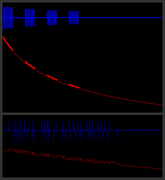As far as I saw from reading this thread, you were unable to read DPM from the .mds format, and switched to using a different format instead. Is that correct?
No. There's probably just a confusion between reading and creating DPM. Reading from files is easy. Creating values from the disc is not.
re-reading the same sector; the time it takes to re-read it each time should be the amount of time it takes to read 360 degrees
Alcohol does not do that. It would add a variable and unpredictable amount of mechanical delay due to the non-continuous read.


